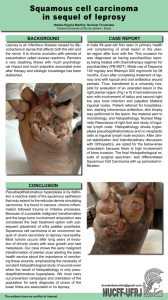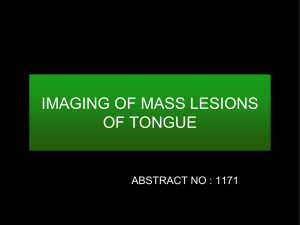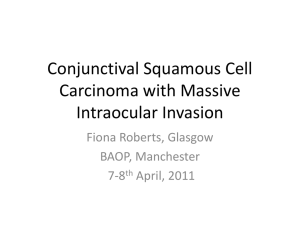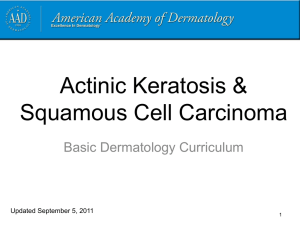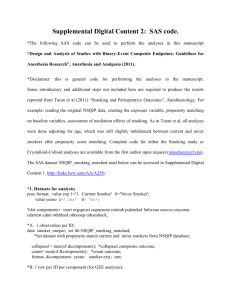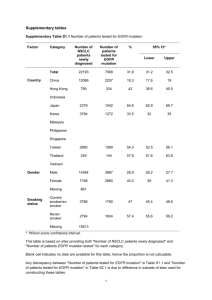Tobacco –Related Lesions
advertisement
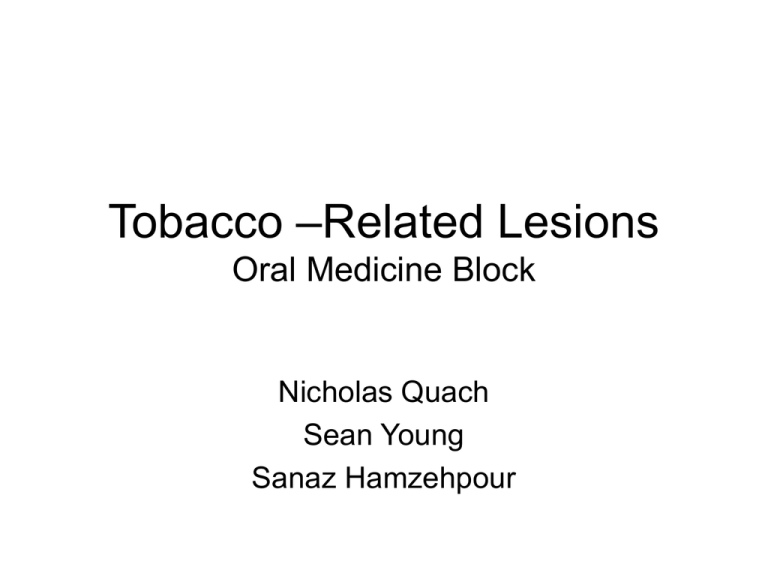
Tobacco –Related Lesions Oral Medicine Block Nicholas Quach Sean Young Sanaz Hamzehpour Smoker’s Melanosis • Background – Constituent of tobacco smoke stimulates increased melanin production. – Common in men & women • More intense in female smokers who also take conraceptive pills. Smoker’s Melanosis • Clinical features – Location: • Most commonly on Max & Mand anterior labial gingiva • Other sites: buccal mucosa, FOM, soft palate Smoker’s Melanosis • Histopathology – Features are similar to those found in a melanotic macule. – Increased melanin deposits are found within basal epithelial cells. – Underlying CT exhibits a mild infiltrate of lymphocytes. Smoker’s Melanosis • Treatment – Cessation of smoking. – Pigmentation goes away within a few months. – If pigmentation persists, biopsy the lesion. Snuff Dipper’s Lesion/Pouch • Background – Keratotic changes in response to chronic smokeless tobacco use. – Different from leukoplakia. Snuff Dipper’s Lesion/Pouch • Clinical features – Localized in areas with direct contact with smokeless tobacco. – Fissured, poorly demarcated, & soft velvety feel Snuff Dipper’s Lesion/Pouch • Histopathology – Squamous epithelium is hyperplastic and hyperkeratinized. – Intracellular edema of superficial layers which results in a translucent/edematous clinical appearance. • Treatment – Biopsy may be indicated to rule out cancer. – Cessation of use of smokeless tobacco. Nicotinic Stomatitis • Background – Palatal lesion seen in smokers. – Concentrated heat from burning of the tobacco produces the lesion. – Most often observed in pipe and reverse cigarette smokers. Nicotinic Stomatitis • Clinical features – Usually lesions are in the posterior hard palate and adjacent soft palate. – Reddened area that changes to a thickened, white appearance & wollen minor salivary gland orifices become dilated and are seen as speckled red dots. Nicotinic Stomatitis • Histopathology – Lesions are acanthotic and hyperkeratotic. – Mild to moderate chronic inflammation. – Epithelium of minor salivary gland ducts may shouw aquamous metaplasia. • Treatment – Smoking cessation. Black Hairy Tongue • Background – Desquamation of filiform papillae resulting from various factors. Black Hairy Tongue • Clinical features – Black dorsum of tongue. – Hairy tongue can be black due to tobacco smoke, but can be other colors depending upon precipitating factors. Black Hairy Tongue • Histopathology – Hypertrophy and elongation of filiform papillae, which can be as long as 15 mm. • Treatment – OHI – Determination of cause, ie: tobacco smoking. – Smoking cessation. Submucous Fibrosis • Background – Usually involves the chewing of betel quid, which also contains tobacco. Submucous Fibrosis • Clinical features – Stiffening of mucosa typically affects the buccal mucosa, lips, retromolar pads. – As the disease progresses, it may involve the tongue and cause it to be stiff. Submucous Fibrosis • Histopathology – Chronic inflammatory cell infiltration of subepithelial CT. – Nonspecific infiltration of eosinophils. – Reduced vascularity of tissues is possible. Submucous Fibrosis • Treatment – This condition is irreversible once formed. – No effective treatment. – Surgery may be indicated to improve oral conditions. Squamous Cell Carcinoma • Pathogenesis: – A malignant neoplasm of the stratified squamous epithelium that starts as epithelial dysplasia and ends as the dysplastic epithelial cells invade the basement membrane thus invading connective tissue. Squamous Cell Carcinoma • Clinical features – Most common clinical oral presentation are leukoplakias and erythroplakias. Advanced lesions first appear as painless ulcers, tumorous mass or verrucous (papillary) growth. – Horse-shoe oral areas are more prone to SCC, which consist of the anterior floor of the mouth, lateral border of the tongue, tonsillar pillars and lateral soft palate. Squamous Cell Carcinoma • Clinical features Squamous Cell Carcinoma • Diagnostic tests – SCC is diagnosed by microscopic examination of a representative biopsy of the neoplastic tissue. Squamous Cell Carcinoma • Histologic appearance: – 3 stages: • Well-differentiated SCC: Microscopic features reveal irregularly elongated rete pegs invading the connective tissue and the presence of keratin pearls. Eg. SCC of the lower lip. • Moderately-differentiated SCC: exhibits an abrupt line of demarcation between the normal epithelium and invasive neoplastic epithelium that is non-keratinized and exhibits loss of cellular cohesiveness. Eg. SCC of the lateral borders of the tongue. • Poorly-diffentiated SCC: exhibits sever cellular abnormalities and hyperchromatism and pleomorphism. Eg. SCC of tonsillar beds. Squamous Cell Carcinoma • Histopathology Squamous Cell Carcinoma • Treatment – SCC is usually treated by surgical excision or radiation therapy or both. Test Question 1 • Which of the following features of smoker’s melanosis is NOT correct? – A. Smoker’s melanosis is benign and should therefore not be biopsied. – B. Pigmentation from smoker’s melanosis resolves itself after patient stops smoking. – C. Smoker’s melanosis is found most commonly on the labial mucosa – D. If patient is taking contraceptives, pigmentation from smoker’s melanosis is more intense Test Question 2 • Which of the following is NOT one of the clinical manifistations of SCC? – A. Tumorous mass – B. Papillary growth – C. Leukoplakias – D. Melanoma
